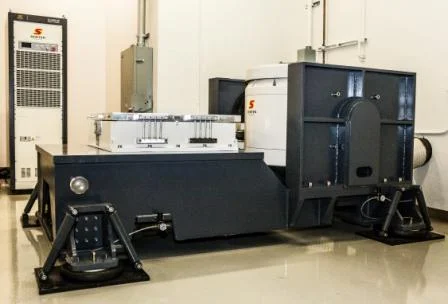This paper discusses the usage and unique features of Multiple-Exciter Single-Axis (MESA) control with Crystal Instruments vibration controller.
MESA is a type of multiple exciter setup with all exciters arranged along a single axis. The goal is to combine the excitation forces and dimensional capabilities from multiple exciters to test a long and/or large Unit Under Test. MIL-STD-810G Method 527 discusses the terminology involving single and multiple exciter testing configurations.
Read moreSentek Dynamics’ THV Series Environmental Test Systems with the Crystal Instruments’ Spider-101 Controller provide a turn-key solution for product development/certification and reliability improvement. The Crystal Instruments’ controller with IEEE Time Synchronization is the optimum solution for combined temperature, humidity and vibration testing of batteries, electrical and electro-mechanical components.
Read moreThe right test equipment is essential to successful product testing. When purchasing a new vibration testing system (shaker) or environmental test chamber, choosing the right model for your test requirements is important. This article provides tips to aid in making the right choice.
Read moreDeveloped by the automotive industry where Swept Sine testing is the standard, Multi Sine is a test type to that reduces the run time by running multiple sine tones simultaneously as opposed to the single sine tone of a standard Swept Sine test. Crystal Instrument’s Multi-Sine tests offer up to 9 simultaneous sine tone sweeps, covering the entire frequency band of the Swept Sine test in a fraction of the time.
Read moreThis article examines the acquisition of modal characteristics from a bullet train wheel by performing experimental modal analysis. The wheel vibrations affect the dynamics of the wheel-rail interactions. Understanding these vibration characteristics will help mitigate the vibration and noise at high speeds.
Read moreIt is our pleasure to announce that Sentek Dynamics is expanding our business with a new office location:
Sentek Dynamics Corporate Office
2090 Duane Avenue
Santa Clara, CA 95054
Read moreExecuting a sine vibration control test is a common method of verifying the performance of the manufactured product under real world conditions. However, there are various challenges that could hinder a successful sine sweep test. These challenges include system structural dynamics (resonances and anti-resonances present in the system), sensor placement location, measurement dynamic range, and sensor quality and mounting method.
Read moreThis article examines the acquisition of modal characteristics from a disc brake rotor by performing experimental modal analysis. Brake systems are required for safe vehicle operation. The major component of a brake system is the disc brake rotor. While braking, the excitation frequency level can match natural frequencies and this phenomenon of resonance can cause the brake to squeal, potentially generating unpleasant vibration and noise.
Read moreWatch the new Spider-80Ti video produced by Aakash Umesh Mange, Application Engineer at Crystal Instruments. The Spider-80Ti is a front-end from the Spider-80Xi hardware platform that enables temperature measurement. Spider-80Ti supports temperature measurements from Thermocouples and RTD (Resistance Temperature Detector) sensors.
Read moreRandom control is a fundamental vibration test for various industries and manufacturers of products. The FFT based control algorithm transforms time signals to the frequency domain where analysis, calculation, comparison…average, (etc.) are done. The performance of Random control is determined by how well the FFT describes the system characteristics. Proper spectrum resolution must be chosen in order to avoid missing any desirable observations and to meet the requirement of the control performance.
Read more
